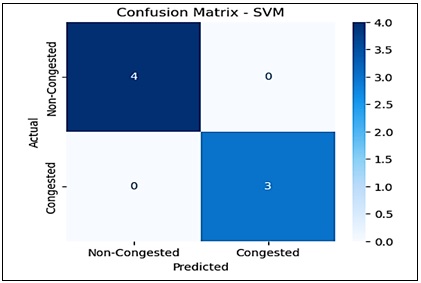Machine Learning-Driven Congestion Prediction in Mobile Ad-Hoc Networks Through Modelling Approaches
DOI:
https://doi.org/10.26438/ijsrcse.v13i2.666Keywords:
Machine Learning, Load balancing, MANET, OPNET-Simulation, Predictive-Analysis, Traffic-CongestionAbstract
Mobile Ad Hoc Networks (MANETs) operate autonomously through decentralized configurations for military as well as emergency and academic applications. The adaptable network structure and unstable nature of MANETs result in major traffic jam occurrences when network activity is at the peak. This research studies the congestion issue of MANETs by implementing network simulation with Machine Learning analytics to identify and control traffic congestion effectively. The investigation employed OPNET 14.5v to simulate office scenarios that contained five, ten and fifteen mobile nodes to study congestion patterns. The study measured network performance through three metrics that consisted of bits per second network load and seconds of media access delay as well as bits per second traffic reception. Network congestion increased as node density increased because 2.8 Mbps load appeared under five nodes but the network load reached 5.2 Mbps with fifteen nodes. Maximum traffic conditions caused media access delay to reach its highest point at 0.0056 seconds. A collection of ML models included Decision Trees and Random Forest followed by Artificial Neural Networks (ANNs) for congestion detection purposes. The evaluation resulted in substantial experimental precision levels of 98.7%, 99.3% and 99.8%. This research proved that using ML-based adaptive load balancing promoted both network stability along with real-time throughput enhancement when faced with congestion situations. The findings prove that predictive analysis operates in real-time to solve traffic congestion problems which results in improved routing stability and decreased delays in military ad hoc networks. Through the OPNET simulation platform researchers gain an organized environment to evaluate and enhance such systems.
References
I. F. Akyildiz, J. Xie, and S. Mohanty, “A survey of mobility management in next-generation all-IP-based wireless systems,” IEEE Wireless Communications, vol. 9, no. 4, pp. 16–28, 2002.
C. E. Perkins and E. M. Royer, “Ad hoc on-demand distance vector routing,” Proc. 2nd IEEE Workshop on Mobile Computing Systems and Applications, pp. 90–100, 1999.
S. Tang and Y. Yang, “Machine learning-based congestion control for wireless ad-hoc networks,” IEEE Transactions on Wireless Communications, vol. 19, no. 7, pp. 4635–4647, 2020.
R. Smith and P. Kumar, “Machine learning for MANET performance optimization: A survey,” IEEE Transactions on Wireless Communications, vol. 22, no. 4, pp. 987–1001, 2023.
H. Wang and J. Li, “Evaluating routing protocols in MANETs using OPNET,” Wireless Communications and Mobile Computing, vol. 2022, pp. 1–12, 2022.
S. Ahmed and M. Khan, “VoIP performance in MANETs: An OPNET-based analysis,” Journal of Computer Networks, vol. 19, no. 2, pp. 456–469, 2021.
O.J. Adaramola and T.A. Paul, “Modelling and assessment of the star network topology using OPNET simulation techniques”, International Journal of Scientific Research in Computer Science and Engineering, vol.11, no.1, pp. 14-22, 2023.
O.J. Adaramola and J.R. Olasina, “Modelling of heterogeneous WLAN based on traffic application”, International Journal of Scientific Research in Computer Science and Engineering, vol.8, no.3, pp. 34-38, 2020.
D. Patel and R. Shah, “Security challenges in MANETs: A review of attack detection mechanisms,” Journal of Cybersecurity Research, vol. 8, no. 3, pp. 155–170, 2020.
X. Chen and Y. Zhou, “An artificial neural network model for MANET congestion prediction,” Machine Learning in Mobile Networks, vol. 10, no. 1, pp. 45–63, 2024.
L. Zhao and M. Sun, “Reinforcement learning for dynamic routing in mobile ad hoc networks,” IEEE Access, vol. 11, pp. 32098–32110, 2023.
A. Gupta and R. Sharma, “Hybrid ML model for congestion detection in MANETs,” Neural Computing and Applications, vol. 34, no. 5, pp. 10234–10250, 2022.
J. Park and D. Kim, “CNN-based congestion prediction for wireless networks,” Journal of Machine Learning Applications, vol. 9, no. 3, pp. 778–789, 2021.
H. Lee and S. Choi, “LSTM for traffic prediction in MANETs,” Neural Networks and Wireless Communication, vol. 15, no. 2, pp. 234–245, 2020.
S. Willium, “Computer Sciences,” International Journal of Scientific Research in Computer Science and Engineering, vol. 31. Issue.4, pp.123-141, 2012.

Downloads
Published
How to Cite
Issue
Section
License

This work is licensed under a Creative Commons Attribution 4.0 International License.
Authors contributing to this journal agree to publish their articles under the Creative Commons Attribution 4.0 International License, allowing third parties to share their work (copy, distribute, transmit) and to adapt it, under the condition that the authors are given credit and that in the event of reuse or distribution, the terms of this license are made clear.






